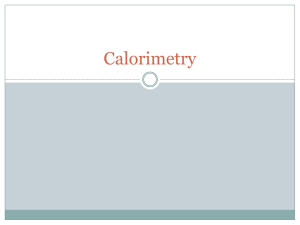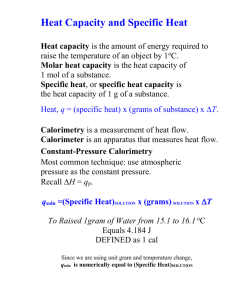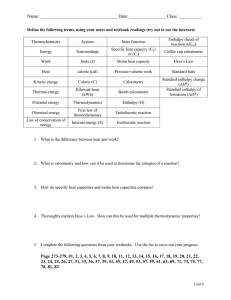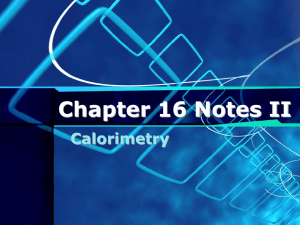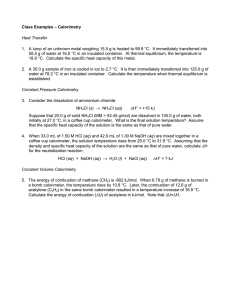SOLUTION CALORIMETRY Experiment 7 Stephen E. Schullery PURPOSE
advertisement
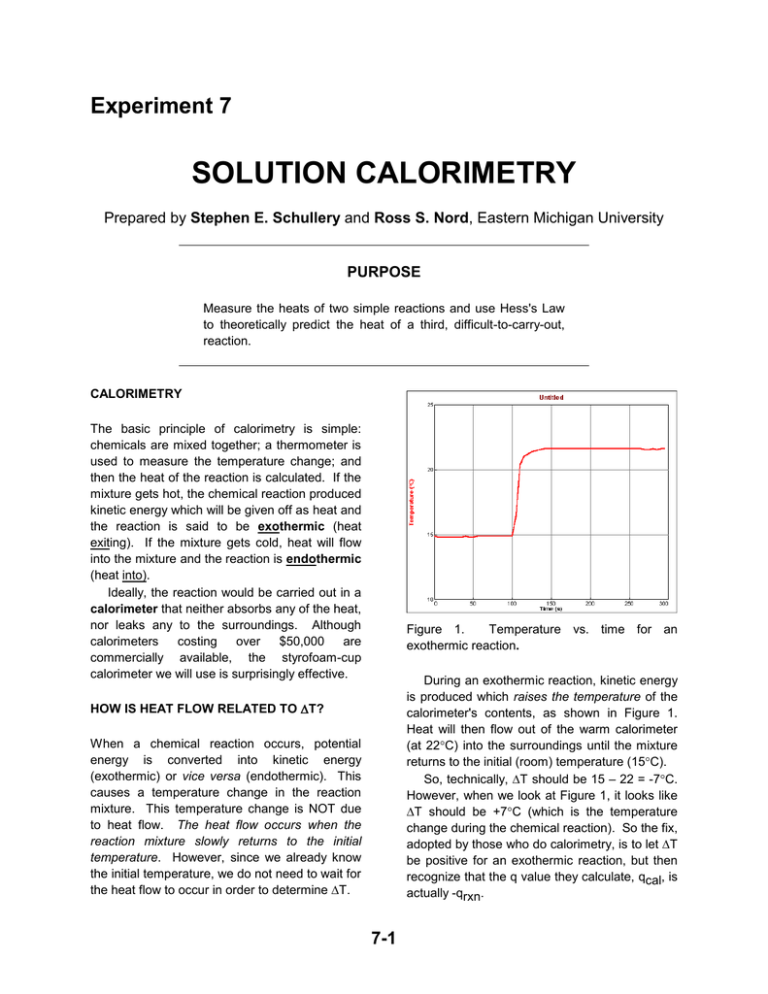
Experiment 7 SOLUTION CALORIMETRY Prepared by Stephen E. Schullery and Ross S. Nord, Eastern Michigan University PURPOSE Measure the heats of two simple reactions and use Hess's Law to theoretically predict the heat of a third, difficult-to-carry-out, reaction. CALORIMETRY The basic principle of calorimetry is simple: chemicals are mixed together; a thermometer is used to measure the temperature change; and then the heat of the reaction is calculated. If the mixture gets hot, the chemical reaction produced kinetic energy which will be given off as heat and the reaction is said to be exothermic (heat exiting). If the mixture gets cold, heat will flow into the mixture and the reaction is endothermic (heat into). Ideally, the reaction would be carried out in a calorimeter that neither absorbs any of the heat, nor leaks any to the surroundings. Although calorimeters costing over $50,000 are commercially available, the styrofoam-cup calorimeter we will use is surprisingly effective. Figure 1. Temperature vs. time for an exothermic reaction. During an exothermic reaction, kinetic energy is produced which raises the temperature of the calorimeter's contents, as shown in Figure 1. Heat will then flow out of the warm calorimeter (at 22C) into the surroundings until the mixture returns to the initial (room) temperature (15C). So, technically, T should be 15 – 22 = -7C. However, when we look at Figure 1, it looks like T should be +7C (which is the temperature change during the chemical reaction). So the fix, adopted by those who do calorimetry, is to let T be positive for an exothermic reaction, but then recognize that the q value they calculate, qcal, is actually -qrxn. HOW IS HEAT FLOW RELATED TO T? When a chemical reaction occurs, potential energy is converted into kinetic energy (exothermic) or vice versa (endothermic). This causes a temperature change in the reaction mixture. This temperature change is NOT due to heat flow. The heat flow occurs when the reaction mixture slowly returns to the initial temperature. However, since we already know the initial temperature, we do not need to wait for the heat flow to occur in order to determine T. 7-1 Experiment 7 - Calorimetry The fundamental equation of calorimetry, shows how qcal depends on C, the system's heat capacity, and T: qcal = CT assumed to be zero. However, with many calorimeters, or whenever extreme accuracy is required, allowance must be made for the heat capacity of both the calorimeter and its contents. (1) Table I. Specific Heats at 298 K. The solution calorimeter used in this experiment is open to the atmosphere (at constant pressure), so qrxn = H = -qcal. Thus, we see for an exothermic reaction, T is positive, making qcal positive and H negative, just as it is supposed to be. solution (mol/L) (J/g-C) NH4Cl(aq) NH4NO3 (aq) HEAT CAPACITIES 4.04 4.01 (mol/L) (J/g-C) 0.9 0.6 solution M (mol/L) density (g/ml) H2O (l) HCl (aq) HNO3 NH4OH (aq) pure 1.0 1.0 1.0 0.997 1.02 1.03 0.992 DETERMINING CHANGE 3.93 3.98 THE TEMPERATURE (2) Although there is little doubt about the temperature at the start of a reaction, the temperature after the reaction is more uncertain. This is because the reaction takes time, and the energy needs time to diffuse through the mixture, and the thermometer needs time to respond. During this time, our good-but-notperfect calorimeter is leaking heat (the contents are returning to room temperature). There is a clever graphical way to determine what the products' temperature would have been if the calorimeter had not leaked any heat: Temperature measurements are continued after the reaction, until only the slight, steady drift due to the heat leak is occurring. This drift line is extrapolated back to the time of mixing, and the temperature at that point is taken as the correct final temperature. Figure 2 illustrates this process. The specific heats of the products are used since the heat flow occurs after the products are formed. These are given in Table I. The mass of products must equal the mass of the reactants (conservation of mass). The mass of liquid reactants can be determined from their densities and volumes. The densities of the reactant solutions used in this experiment are given in Table II. Thus, the total heat capacity of a solution can be calculated as C = (cs) [(V1)(d1) + (V2)(d2)] for mixtures of two liquids 0.5 0.5 Reaction B. M cs Table II. Densities at 298 K. The heat capacity used in Equation 1 is the total heat capacity of the system. It is the amount of energy required to raise the temperature of the entire sample by one degree. Because it is not possible to know the size of every sample someone might use, published values of heat capacities are always given either as molar or specific heat capacities. We use the specific heat, cs, in this experiment. cs is the energy needed to raise the temperature of one gram of a substance by one degree. C = specific heat x mass Reaction A. M cs (3) C = (cs) [(V) (d) + masssalt] (4) for mixtures of liquid and salt The heat capacity of the empty calorimeter setup used in this experiment is negligible and 7-2 T Figure 2. Temperature vs. time for an endothermic reaction. The square brackets enclose the points used to determine (by linear regression) the lines that are extrapolated to determine T. permits us to indirectly determine the heat of this reaction by carrying out two other more convenient reactions: USE OF HESS'S LAW TO INDIRECTLY OBTAIN THE HEAT OF A REACTION The change () in any extensive state function during a reaction is the sum of the ’s for any sequence of reactions that adds up to the same overall reaction. This simple fact, when applied to changes in the state function enthalpy H, is known as Hess's Law. In this experiment, Hess's Law will be used to determine the heat of an acid-base neutralization to produce a solid salt: Reaction A, the "usual" neutralization of aqueous acid and base to give an aqueous salt solution, acid(aq) + base(aq) salt(aq) + H2O(l) HA and Reaction B, the dissolution of pure solid salt to give an aqueous salt solution, salt(s) salt(aq) acid(aq) + base(aq) salt(s) + H2O(l) HB Notice that if reaction B is reversed and then added to reaction A, the desired reaction (C) results: Note that an aqueous salt solution, rather than the solid salt, would normally result from acidbase neutralization. However, Hess's Law 7-3 Experiment 7 - Calorimetry salt(aq) salt(s) acid(aq)+base(aq) salt(aq)+H2O(l) -------------------------------------------------acid(aq)+base(aq) salt(s)+H2O(l) IN THIS EXPERIMENT -HB HA --------HC The H of two different reactions will be measured: (A) neutralization of aqueous ammonia (NH4OH) with a strong acid (HCl or HNO3), and (B) dissolution of the corresponding ammonium salt (NH4Cl or NH4NO3) in water. These results will be combined using Hess's Law to theoretically calculate the H of a third reaction (C) the aqueous ammonia - strong acid neutralization to produce the pure ammonium solid salt and water. When reaction B is reversed, the sign is changed in front of HB. Then, by Hess's Law, HC is the sum of HA and -(HB). Thus, with the help of Hess's Law, we can predict the heat of a reaction that may be impossible to actually carry out. Chemists use this trick a lot. Sometimes the information gained is of only theoretical interest; often it is useful for calculation of other reaction heats. PRE-LABORATORY PREPARATION 1. Read the procedure and data analysis sections of the experiment. 2. Set up the DATA SHEET for the experiment. Since all of the data will be collected by computer, the data sheet only needs to contain the actual concentrations and amounts of all of the reagents used. 3. Complete the computer-generated prelab assignment for this experiment. You will be given sample data for one calorimetric run. This should be analyzed as described in DATA ANALYSIS, exactly as you will have to analyze your own data in the lab. It is best to use the GRAPHICAL ANALYSIS program to draw the graph needed to obtain T. ALLOW PLENTY OF TIME TO DO THIS PRELAB. EXPERIMENTAL SECTION REAGENTS PROVIDED Hazardous Chemicals Standardized ammonia, 1 M. Aqueous Ammonia bottles are sometimes labeled NH3(aq) and sometimes NH4OH(aq) Record the exact concentration on your data sheet. Standardized hydrochloric acid, 1 M. Record the exact concentration on your data sheet if this is your assigned acid. Standardized nitric acid, 1 M. Record the exact concentration on your data sheet if this is your assigned acid. Ammonium chloride, solid. Ammonium nitrate, solid. Be careful not to spill any solutions on your person, especially the acids and bases. Immediately wash off any spilled solution with lots of water. WASTE DISPOSAL All of the chemicals used in this experiment may be safely disposed of by washing down the sink. 7-4 Experiment 7 - Calorimetry SPECIAL EQUIPMENT styrofoam calorimeter (which consists of a pair of nested cups) 50.0 mL of whichever solution contains the limiting reactant. It is okay if the volume isn’t exactly 50.0 mL. However, record the actual volume used on your data sheet (to the nearest 0.1 mL). Because equal volumes of the solutions are to be used, you can decide which contains the limiting reactant simply by comparing the precise concentrations given on the labels (calculations are not required). The limiting reactant is added first, because addition of the second reactant is a little more rushed and subject to error. Keep the solution covered as much as possible to minimize evaporative cooling. The following items are available on the front bench (and should be returned there after lab): 2 styrofoam cups with a cardboard cover Stainless steel temperature probes PROCEDURE This experiment could be done individually, but due to equipment limitations you will do the experiment with a partner (or two, if necessary). Because data will be collected by computerinterfacing, YOU MUST WORK AT A STATION WITH ACCESS TO A COMPUTER. 6. Put the cardboard cover over the calorimeter and insert the temperature probe through the hole in the cover so that the end of the probe is in the solution. Be sure the probe will not tip over the calorimeter when you take your hand away. It will sometimes do this if the cord is twisted. If you are having trouble getting it to stay upright, wrap the cord around a buret stand. COMPUTER/TEMPERATURE PROBE SETUP 1. Double-click on the LOGGER PRO icon from the desktop. If the interface box icon does not appear in the upper left, be sure it is connected to the computer and plugged in and restart Logger Pro. 2. Attach a stainless steel temperature probe to CH 1 of the interface box. 7. Add 50.0 mL of the second reactant to a graduated cylinder, but do not add it to the calorimeter yet. Keep it covered by inverting a small beaker over the top of the cylinder. Record the actual volume on your data sheet. 3. Check to be sure the readings make sense. You should see the temperature reading at the bottom of the screen under the graph. If not, click on Experiment and then Live Readouts. REACTION A: AQUEOUS AMMONIA STRONG ACID NEUTRALIZATION - 8. Setup the data collection routine. The default values for Logger Pro work very well for this experiment and so we do not need to change them. We will sample 2 points per second for 180 seconds. There are two strong acids available. Your instructor will assign you either HCl or HNO3 which you will react with NH4OH. You will use 50.0 mL of both aqueous ammonia and your assigned acid. 4. Record the exact concentrations of the two solutions you use on your data sheet. 9. Begin data collection. Click on the Collect button in the upper right of the screen. You should see data appearing in the data table and on the graph. The line on the graph should be flat. 5. Using a 50 mL graduated cylinder, carefully measure into the clean, dry 10. Wait for 60 seconds after starting data collection. Then, WITHOUT stopping the 7-5 Experiment 7 - Calorimetry data collection, slide the calorimeter cover over to one side and pour the solution from the graduated cylinder into the calorimeter. The temperature probe should remain in the solution for the entire time. Replace the calorimeter cover and mix the contents by gently stirring with the temperature probe. (b) Next, Click on Interpolate from the submenu. Now, when you move the cursor across the graph, you should see the x and y values for the best-fit line appear in the new (interpolate) box. (c) Move the cursor so the Time (x) value is approximately what it was when you added the second reactant to the calorimeter (around 60 seconds). (d) Read the Temperature (y) value in the box. Record this value as the final temperature in the Table for Data Analysis question 1 (rounded to the nearest 0.1oC). 11. After data has been collected for 180 seconds, data collection will stop automatically. Remove the temperature probe from the solution and dry it with a paper towel. Dispose of the solution down the drain. Rinse and dry the styrofoam cups. 15. Print out a copy of the graph. The program automatically labels the axes, but you should enter a title (Temperature vs. Time – Reaction A). Do not bother printing out the data table. DETERMINATION OF T 12. Exam the Logger Pro data table to see the temperature of the mixture at 60 s (immediately before mixing). Record this (to the nearest 0.1C) as the initial temperature in the Table for Data Analysis question 1. REACTION B: DISSOLUTION OF AMMONIUM SALT IN WATER. Here you will repeat the calorimetric procedure, except, as the first reactant, use 100 mL distilled water, and, as the second reactant, use 5 grams of the ammonium salt (NH4Cl, NH4NO3) corresponding to the acid used in REACTION A. 13. Perform linear regression on the flat region of the graph after the reaction is over: a) Autoscale the graph. b) Click-and-drag, using your mouse, to select the flat region at the right end of the graph. Use your best judgment as to which points to select. Typically, you will use points between 90 and 180 seconds. See Figure 2 for an example. c) Click on the linear regression icon. This is the icon with a straight line drawn through a curve and the partial equation “R=”. A box should appear containing the slope, m, and y-intercept, b, of the best-fit line. d) If the regression box appears on top of the line, click anywhere in the box, hold the mouse button down, and drag it to a part of the graph where it does not hide anything of interest. 16. Weigh out onto glassine weighing paper about 5 grams of your assigned salt. Break up the solid with your spatula so that it is not in chunks before weighing it. If the solid is in chunks it will cause erratic temperature changes as it dissolves. Glassine paper is preferred as no sample will stick to the paper. Any amount close to 5 grams is okay, but you need to know exactly what the actual weight is. Record on your DATA SHEET the exact amount weighed out (to the nearest 0.001 g). 17. Using a 50 mL graduated cylinder, add 100 mL of distilled water to the clean and dry styrofoam calorimeter cup. Record the actual volume used (to the nearest 0.1 mL) on your data sheet. 14. Determine the final temperature: (a) Choose Analyze from the top menu. 7-6 Experiment 7 - Calorimetry 18. Cover the calorimeter and place the temperature probe in the solution, as before. rinse it will some distilled water, and dry it with a paper towel. Dispose of the solution down the drain. Rinse and dry the styrofoam cups. Return them to the front bench. 19. Begin data collection by clicking on the Collect button. The program should ask if you want to erase the previously-collected data. If you have calculated T and printed out the graph for Reaction A, you should choose Erase and Continue to cause data collection to begin. Otherwise, go back and do this before erasing your data. 22. Determine T for this reaction and print the graph following the same procedure described in steps 12-15. The regression box from the first reaction will remain on the graph. It is simplest to delete it and create a new one. Record your results for the initial and final temperatures in the Table for Data Analysis question 1. Print out the Temperature vs. Time graph for this reaction, as well. For the title enter Temperature vs. Time – Reaction B. When you exit from Logger Pro you should not need to save your data. You should have your two graphs printed and the values for the initial and final temperatures for both calorimetric runs. 20. After data has been collected for 60 seconds, slide the calorimeter cover over to one side and pour the salt into the calorimeter. The temperature probe should remain in the solution for the entire time. Replace the calorimeter cover and mix the contents by stirring with the temperature probe. It is essential that the sample be stirred enough to dissolve all of the salt. If it dissolves too slowly, the temperature change will be slow and erratic. After the run, look closely to see if all of the salt has dissolved; if it has not, the run must be repeated USE A BRUSH AND TAP WATER TO CLEAN YOUR GLASSWARE. RINSE IT WITH DISTILLED WATER AND DRY IT BEFORE RETURNING IT TO THE DRAWER. 21. After data has been collected for 180 seconds, data collection will end. Remove the temperature probe from the solution, It's always a good idea to wash your hands after handling glassware containing any chemicals. 7-7 Experiment 7 - Calorimetry Name Partner Station Used Partner Instructor/Day/Time Station Checked & Approved DATA SHEET You must construct a complete, organized data sheet to be used for recording all data during the experiment. (See the Pre-Laboratory Preparation section of the experiment for a list of what must be included on your data sheet.) 7-8 Experiment 7 - Calorimetry DATA ANALYSIS 1. Enter the relevant data into the table below and calculate T (Tfinal – Tinitial) for each reaction. Reaction Tfinal (oC) Tinitial (oC) T (oC) A B CALCULATION OF MOLAR REACTION ENTHALPIES For each calculation below, show your work in the space provided. Show your calculation for each reaction, A and B, on its own side of the page. 2. Using the specific heat of the product solution from Table I (ammonium chloride if HCl was used, ammonium nitrate if HNO3 was used) and the mass of product solution formed , calculate the heat capacity of the reaction products (using equation 3 for Reaction A and equation 4 for Reaction B). The densities are close enough, even if the concentrations are not exactly 1.0 M. REACTION A. REACTION B C = ________________________________ C = ________________________________ 7-9 Experiment 7 - Calorimetry 3. Calculate qcal for both reactions in kJ (use equation 1). Then, give the value for H in kJ. Since the reactions were carried out at constant pressure, H = -qcal for each reaction. (Recall the minus sign appears because of how T is determined in calorimetry--see the background section entitled How is Heat Flow Related to T?.) REACTION A REACTION B qcal = _______________________________ qcal = _______________________________ H = ________________________________ H = ________________________________ 4. Calculate the moles of the limiting reactant for reaction A (from its molarity and volume), and the moles of salt added in reaction B. Molar masses: NH4Cl, 53.49 g/mol; NH4NO3, 80.04 g/mol REACTION A REACTION B n = ________________________________ n = ________________________________ 7-10 Experiment 7 - Calorimetry 5. Convert the H values, calculated in question 3, into molar enthalpies of reactions, by using the moles of the limiting reactant (A) or moles of salt (B). A molar enthalpy is H per mole. REACTION A REACTION B H = ________________________________ H = ________________________________ USE OF HESS'S LAW TO INDIRECTLY DETERMINE H OF REACTION C. 6. Write the complete balanced equations for both reactions studied in the calorimeter. Use NH4OH(aq) as the formula of the aqueous ammonia. Do NOT write net ionic reactions. Indicate the phase of each species in the reactions. [See the background section of the experiment on Hess’s Law for general examples.] REACTION A: Aqueous Ammonia – Strong Acid Neutralization REACTION B: Dissolution of Ammonium Salt in Water 7-11 Experiment 7 - Calorimetry 7. Rewrite REACTIONS A and B, reversing directions as necessary, to show how they can be combined to give REACTION C, the reaction of aqueous ammonia with aqueous strong acid to produce the solid ammonium salt and water. Beside each reaction, write the molar enthalpy of reaction for that reaction. Because the reactions are balanced using stoichiometric coefficients, the corresponding molar enthalpies should be used. Be careful to use the proper sign for H based upon the direction the reaction is written. 8. Calculate the molar enthalpy of reaction for REACTION C. H, molar enthalpy of reaction for REACTION C = ______________________ TURN IN your DATA SHEET, the DATA ANALYSIS pages, and your graphs for both calorimetric runs. 7-12

